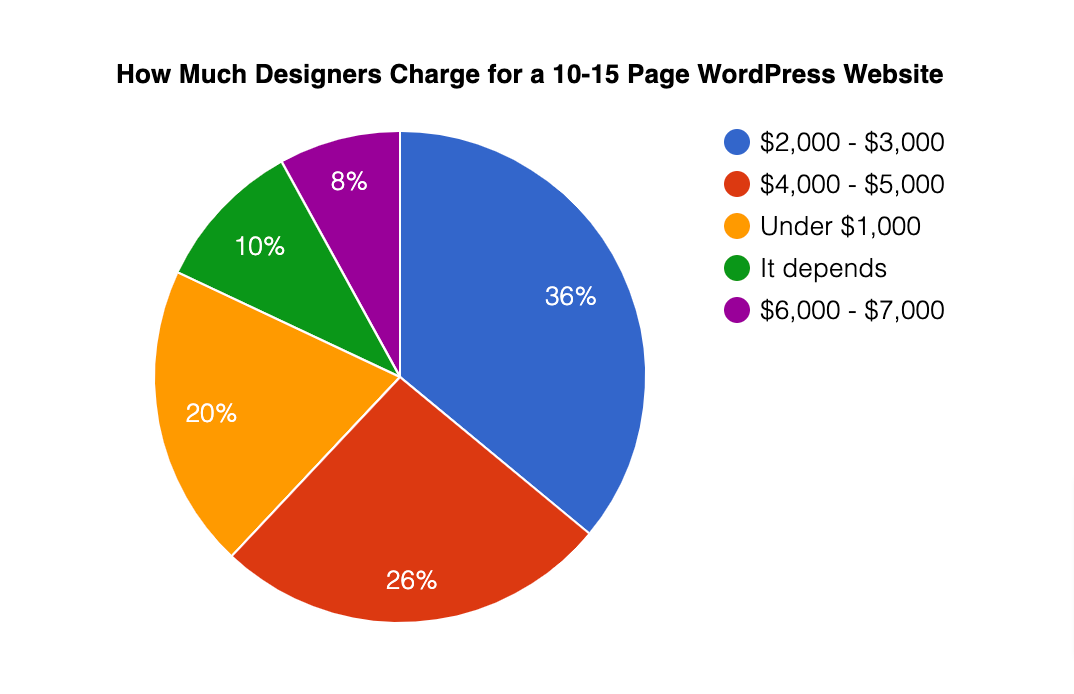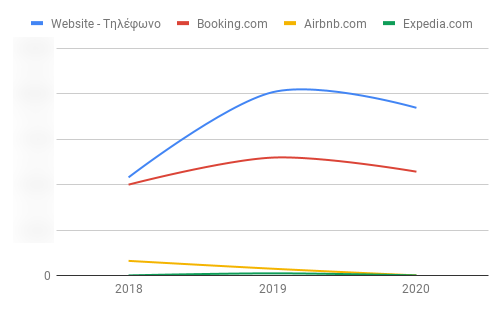
Cost
Until now, we have seen all the important steps to build a great website.
Where it will get visitors from and how to convert them into customers.
We saw how to start from recognizing the motive behind searches and choosing the battles to fight, the competition, search engines, as well as what needs to be done on the website itself: speed, content, user experience, but also off-site factors, backlinks, brand name, etc.
How much would something like that cost?
In a way, the question “how much does it cost” is a bit like asking “how much does a house cost?”.
Meaning, the answer depends a lot on what kind of house the person asking needs. Which location they want (domain name, server), how many rooms (content, architecture), what design they want to follow, etc.
However, because today it is much simpler compared to the past to create a website, you might be surprised how affordable building a website can be if you are willing to get your hands a little dirty, that is, to be actively and seriously engaged!
As seen in Chapter 4: the site, for something to be accessible via the internet, the following must exist:
- Domain name: the unique address of the website.
- A server, meaning the hardware and software that serve the necessary files and handle requests from a client.
- A file system with the website’s information.
Domain
The price of a domain name depends on its top-level domain (TLD), i.e., whether it’s .gr, .com, .org, .me etc.
.gr domains cost around 10-15 euros/year, while .com are slightly cheaper.
The price often depends on the company from which you buy the domain (e.g. Papaki.com, Godaddy.com, etc.).
Then there are many companies reselling domain names already owned by others who no longer need them, or expired domains with good backlink profiles and established presence.
These domains are much more expensive, starting from several tens of euros up to thousands, depending on how strong they were historically.
For starting a presence, I personally don’t consider buying an old domain necessary, which can have negatives (e.g., may have been penalized by Google for unfair practices), and anyway a very good research should be made before proceeding with such a purchase.
However, if there is an old domain with good historical presence abandoned or whose representing company stopped operations and it relates to your business goals, it might be worth trying. Sites like auctions.godaddy.com, namejet.com and expireddomains.net can be used to search and buy old domains.
Server
Server cost depends on the quality chosen.
The server, a set of computers and software used to store and send files to run a website, can host many pages and websites or only one.
Usually most small-medium websites are hosted on servers rented from companies for a specific period.
The cost depends on hosting type and length, plus storage capacity: a typical cost (2022) is about 10-20 euros/month.
File system
Now the third — and costliest — part of a website: its file system and content.
The file system includes the site’s design and functionality, practically all material visitors interact with.
Content includes all information visitors see and that might convert them: text, images, video, etc.
The file system cost depends on the technology proposed and chosen (e.g. WordPress, Drupal, Squarespace, Wix), whether static or dynamic (I strongly recommend dynamic sites), and if design is template-based or uniquely crafted by a designer to your needs.
Obviously, the file system cost includes the developer’s fee to “set” the system on the server.
Theme / Design
A big advantage of using content management systems like WordPress is the ability to change your site’s design using pre-built “themes,” instead of designing from scratch.
You can install a theme in a few clicks and later customize it to fit your needs with an interface friendly even to beginners.
Most website software today (WordPress, Squarespace, Wix, etc.) offer both free and premium (paid) themes.
You can start with a free one, experiment and test, then when ready improve or buy a premium theme.
Image 12.1: Research on how much 111 designers charge for unique WordPress sites 10-15 pages (source: themeisle.com).

A important remark!
In my years working on and managing websites, I’ve seen many beginners “play” with themes they find randomly and apply them just because they look nice.
When I see these… I almost want to cry.
Changing a site’s design simply because something else looks nice and is easy can only do harm.
Especially if you are not professional designers or UX experts.
So, the ease of changing themes and design should not lead you to change your site weekly.
Just leave it to a specialist and simply tell them what you think prevents your visitors from converting.
Regarding cost, a free theme is obviously free.
A pre-built theme costs from 10-20 up to 100-200 euros, while a unique design costs from 1,000 euros and up.
Besides design, functionality might have a cost.
Like themes, almost all main site builders let you add functionality via extensions, usually called “plugins” or “apps.”
Like themes, these come in free and premium packages. WordPress.org’s plugin directory alone offers over 55,000 free plugins.
For a very basic site, free solutions might suffice.
However, most sites, whether WordPress or others like Squarespace or Wix, will need at least some premium plugins.
Thus, for a very simple dynamic site on an open-source platform like WordPress, you might spend a few hundred euros for a developer to buy a server, install the software, apply the theme and needed plugins, and link to your domain.
In summary, you can start with something simple that looks good and works well for about 200-300 euros, though a more realistic mid and long term budget once you operate through your site might be at least 500-1,000 euros to allow some premium plugins, functionality or design.
Content
Content makes the biggest and most essential difference in whether your site succeeds in bringing and converting visitors.
Regarding cost, two approaches exist: create the content yourself or outsource it.
Obviously, outsourcing text, images, video filling costs according to volume.
For a few pages, expect at least 200 euros. But I think a full content creation & management contract with a professional costs at least 1,000 euros.
Hence, I strongly oppose this approach.
In Chapter 6 I described how knowing search intent and combining it with business needs yielded major wins for sites I managed.
I believe no content professional will have as much energy and faith in giving the best answers to key queries.
In cases like the Energy Certificates site or Arachova accommodation and the new Parnassos ski resort with Playmobil, it took me time to understand, plan, and implement needed content.
For these reasons, I strongly recommend the owner creates their own content.
Theoretically (though I tried only a few times), one could write content and outsource only parts e.g. professional images, infographics, or videos accompanying text.
When I tried having a professional produce main text content, I was unhappy and the site never ranked well.
So a hybrid model is also viable: content creation mainly by owner and professional only for specific assets like images, infographics, videos.
Hence, content cost mainly concerns the owner’s energy and time to produce, manage, edit, and improve it as needed.
We saw the creation and management cost of a WordPress-based dynamic site with the simplest structure starts at about 200-300 euros, with annual maintenance about 150-200 euros.
Complex and unique sites definitely cost several thousand euros initially and for better hosting.
But instead of just seeing costs, consider how much benefit the site generates.
Let’s see this with Arahova Pansion’s example.
Understanding the logic of profit calculation from a properly functioning site, one can easily do the same for their own site on their area of expertise.
I estimated Arahova Pansion’s annual site costs as follows:
- Domain: 12 euros/year.
- Server: 150 euros/year.
- CMS: free (open-source WordPress.org).
- Installation: free (I did it myself).
- Theme/template: free.
- Content: free (I wrote it myself).
Total: 162 euros / year.
In Chapter 11: Use Other Platforms, commissions for Booking, Airbnb, Expedia, etc. start at 15%.
The more direct bookings from arahova-pansion.gr, the more money I save otherwise paid to Booking.com and others.
Below is a chart of bookings by channel.
Image 12.2: Booking channels for Arahova Pansion. Most bookings come from official company website.

It appears about 60% of bookings come direct via the official site.
According to the chart, about 60% of Arahova Pansion’s bookings are direct, while the remaining 40% are from external channels, dominated by Booking.com with a 15% commission.
Let’s suppose annual revenue in those years (2018-2020) was around 20,000 euros.
Since for 60% of that I avoid 15% commission (actually often higher since Booking adds 1.5% payment handling fee, not included here), the site operation alone annually earns me from saved commissions:
- 20,000 x 60% x 15% = 1,800 euros
So financials are clear.
It earns 1,800 euros from avoided commissions (actual gain is larger) while costing 162 euros annually.
Profit from commissions saved: 1,638 euros / year.
This means I could reinvest 1,638 euros annually to improve arahova-pansion.gr and still not lose, as this sum is profit from commission savings.
Of course, reaching this profit took about 3-4 years of effort, investing time creating authoritative content about accommodation in Arachova.
Which I eventually succeeded.
From this example, it is very clear: considering real cost for site creation and upkeep plus owner’s energy and time investment in content creation against real benefit from proper operation, is the best metric to decide if a website is worth it.
For Arahova Pansion, this was +1,638 euros/year for some years (2018-2020).
If something else gave me more money for the same effort, maybe I’d do that instead of arahova-pansion.gr.
But for me, the value and experience from developing and running the site far exceed 1,638 euros/year: for example, this book documents what I learned and share to help others succeed, magnifying the true value beyond mere finances.
Regarding the cost of a good site that converts visitors to customers, I believe one should start simple and gradually move to personalized, complex, pricier solutions as needs and goals grow.
In the beginning, not much money is needed.
Starting simple and affordable helps understand content management effort, contribution of each creation, cost of new functions, user behavior, and mainly how well the owner can handle management and their vision and insights from visitors.
For real cost (or benefit), one must consider creation and maintenance cost along with owner’s energy and time versus the real value from the site’s proper and full operation.
This metric is the most reliable criterion to decide if a website is worthwhile.
A website ultimately is not cheap: it requires time, thought, energy, and money from its owner.
Therefore, the owner must know the value, limits, and role of this presence in the overall business.
However, results, if the site is done and run well, will almost certainly have a positive sign!
And in some cases, the value of a good site relative to cost will be many times higher.
Things to Keep in Mind:
- The question “how much does a site cost” is like “how much does a house cost?” From very little to a lot.
- Start simple with free or cheap solutions and move to specialized proposals as needs grow.
- The cheapest start is about 200-300 euros for something very simple, though a realistic budget might be 500-1,000 euros.
- For ROI, consider real cost plus owner’s time/energy against real benefit from full site operation.
Cover image source: Unsplash.com